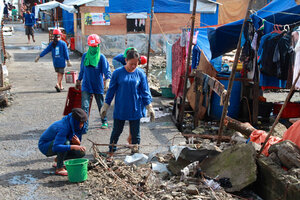Ample aid for Philippine typhoon survivors?
Emergency relief aid poured in immediately after Typhoon Haiyan hit the Philippines. But as the UN turns to long-term recovery, there is little money floating around.

Survivors of Typhoon Haiyan clean up their neighborhood in a UN-funded 'cash for work' program. The overall UN relief and recovery plan so far has less than half the money it says it needs.
Clea Broadhurst / Special to The Christian Science Monitor
Tacloban, Philippines
Testing the assumptions behind the headlines
The world responded generously to appeals for emergency relief and recovery funds after Typhoon Haiyan destroyed or damaged 1.1 million houses in the Philippines in November, forcing more than four million people out of their homes.
Up to a point. The scale of the devastation prompted governments and ordinary citizens worldwide to contribute more money than the United Nations actually thought was needed for immediate emergency shelter, such as tarpaulins, ropes, and tents. But as Filipinos and international aid agencies turn their thoughts to longer term recovery, money is now desperately short.
The UN appeal for funds to pay for something sturdier than a tent has raised less than a quarter of what is needed, according to the UN Office for Coordination of Humanitarian Affairs, which is overseeing the aid effort. And its appeal for money to fund “early recovery and livelihood” projects that would help people get back on their feet, earn some money, and feed themselves is only 17 percent funded.
“Shelter and livelihood are our two top priorities and they are the areas we are most worried about,” says Victor Lahai, deputy head of the OCHA office in Tacloban.
Overall, the UN’s one-year “strategic response plan,” expected to cost $788 million, has been only 42 percent funded, as of this week.
Visiting the Philippines last month, UN Secretary General Ban Ki-moon urged donors to come up with more funds, warning that “we must not allow this to be another forgotten crisis.”
Mr. Lahai fears that “donors might be overstretched” not only by the scale of the disaster that Haiyan wrought but also by the recent crises in South Sudan and the Central African Republic.
The Philippines government has asked the international community to help repair or rebuild 500,000 houses. “But if you are only 22 percent funded, you cannot do housing for 500,000 families,” says Timo Lüge, spokesman for the group of foreign agencies working to build shelter. “It is a big problem.”

